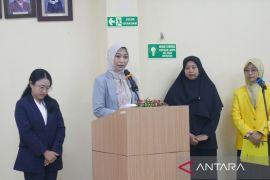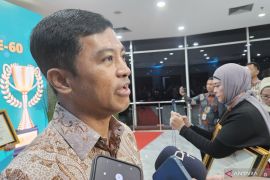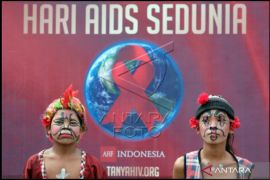It is sad to say that thousands of people carry the AIDS virus but most of whom do not even realize the sex-related disease that has emerged as the number one killer of males in their productive years between 20 - 39.
But ironically sex is being used today in advertisements of everything from soaps to luxury cars, while the sex-related disease of AIDS remains the phenomenon of icebergs that is difficult to terminate.
Official data from the Ministry of Health, quoted by mediaindonesia.com, indicated that in 2011 alone more than 26,000 people were infected by AIDS and over 66,600 others tested HIV positive, and 70 percent of whom were productive young men between 20 -39 years of age.
Year after year the number of people infected by the deadly HIV virus continues to increase, and the epidemic of the virus has spread to almost all areas of Indonesia.
The Ministry of Health has recorded that as of September 2011 AIDS in East Java was the highest with 4,318 cases while Papua was the second with 4,005 cases, followed by Jakarta with 3,998 cases, West Java as the fourth with 3,804 cases, and Bali was at the fifth highest position with only 2,331 cases.
But based on data obtained from the health office of Papua province the number of HIV/AIDS sufferers in Papua had reached 10,522 but it was believed there were still many unrecorded cases.
Head of Papua`s AIDS Eradication Commission Constant Karma said in Sentani early in December 2011 that the number of people living with HIV/AIDS in the province of Papua in 2011 has reached 10,522, or up by 33.47 percent from 7,000 in 2010.
Constant said HIV/AIDS cases in Indonesia`s easternmost province was increasing rapidly and even affecting people in the hinterlands.
"I once predicted HIV/AIDS cases in Papua would continue to increase and therefore, I have always talked about the epidemic, its dangers and how to prevent it," he said.
The HIV/AIDS problem in Papua was becoming a serious threat to the younger generation who are supposed to bear the responsibility for Papua`s future development.
Constant said the HIV/AIDS eradication campaigns his commission was holding would not lower the number of patients but it was at least an effort to prevent it from spreading freely.
Meanwhile, data from Bali provincial AIDS Management Commission (KPA) indicated that around 15,701 people in Gianyar district are prone to HIV/AIDS.
Gianyar KPA spokesman Dewa Made Oka Sedana said early December 2011 that as of September this year 214 HIV/AIDS cases were reported in the district with 24 fatalities.
While in Maluku province, Aids Prevention and Control Commission spokesman Aziz Shamsuddin said in Ambon in June 2011 that the disease continued to spread over the years with the number of HIV/AIDS cases in the period of 1994-2010 was recorded at 1,335, consisting of 615 HIV cases and 720 AIDS cases.
But Maluku Health Office spokesman dr.Ike Pontho said early in December that as of November 2011 the number of HIV/AIDS victims in the province rose to 1,589 with 827 HIV cases and 762 AIDS cases.
The biggest number of people living with HIV/AIDS in Maluku in 2010 was found among the self-employed, prostitutes, and housewives.
In terms of age, most of the HIV/AIDS sufferers or about 82 percent of the total were in the 15-39 years group, four percent in the 0-14 years group and 14 percent in the 40-60 years group, Aziz said.
"HIV/AIDS in Maluku was for the first time detected in Tual in 1994 when it was believed to have been transmitted by a foreign ship`s crew and as of November 2011 a total of 1,589 cases were recorded across the province," Ike Pontho said.
In the westernmost Indonesian province of Aceh, it was reported that of five HIV/AIDS victims who have treatment at a hospital in Banda Aceh in 2011, four have died of the disease.
"Four people have died of HIV/AIDS in 2011 while one of the victims is still being treated in the hospital," Banda Aceh Mayor Mawardy Nurdin said recently.
In a seminar and advocacy management training and capacity building for HIV/AIDS concerned civilian elements organized by the Nahdlatul Ulama Islamic organization`s health institute in Banda Aceh in June this year, Banda Aceh deputy mayor Illiza Sa`aduddin Djamal said new HIV/AIDS sufferers were discovered during a test at a health service.
"It is possible the number of HIV/AIDS cases in Aceh will continue to rise as Aceh people are very open to outsiders while public awareness to medical checks is still low," she said.
Based on KPA data, the number of HIV/AIDS victims up to the end of November 2011 rose to 102 in 21 of 23 districts in Aceh province.
Of 102 HIV/AIDS case in Aceh Province, 80 are still undergoing medical treatment and 22 others have died of that deadly disease.
In reality, HIV/AIDS cases are on the rice in many provinces in Indonesia and will continue to increase in 2012 if nothing is done about that deadly disease.
But in Bali recently, President Yudhoyono and his counterpart Barack Obama of the United States reaffirmed their commitment to work together to meet their shared goal of stemming the spread of HIV/AIDS through the U.S.-Indonesia Comprehensive Partnership.
The U.S. Government is committed to working in partnership with the Government of Indonesia and local communities to stem the spread of HIV/AIDS.
Jointly with the Ministry of Health, National AIDS Commission, and civil society organization, Indonesia and U.S. Government support those affected and engaged in the fight against HIV/AIDS.
U.S. Government activities support and strengthen the Government of Indonesia`s response to the epidemic, build the capacity of civil society organizations that provide services to affected populations, and support for the National AIDS Commission`s Indonesia Partnership Fund.
In 2011, the U.S.Government contributed $13 million in bilateral assistance to Indonesia`s HIV program.
In addition, the Global Fund to Fight AIDS, TB and malaria disbursed $27 million to Indonesia for HIV grants in 2011; the US contributes approximately 30 percent of total Global Fund resources.
(Uu.O001/HAJM/F001)
Reporter: by Otniel Tamindael
Editor: Priyambodo RH
Copyright © ANTARA 2011












